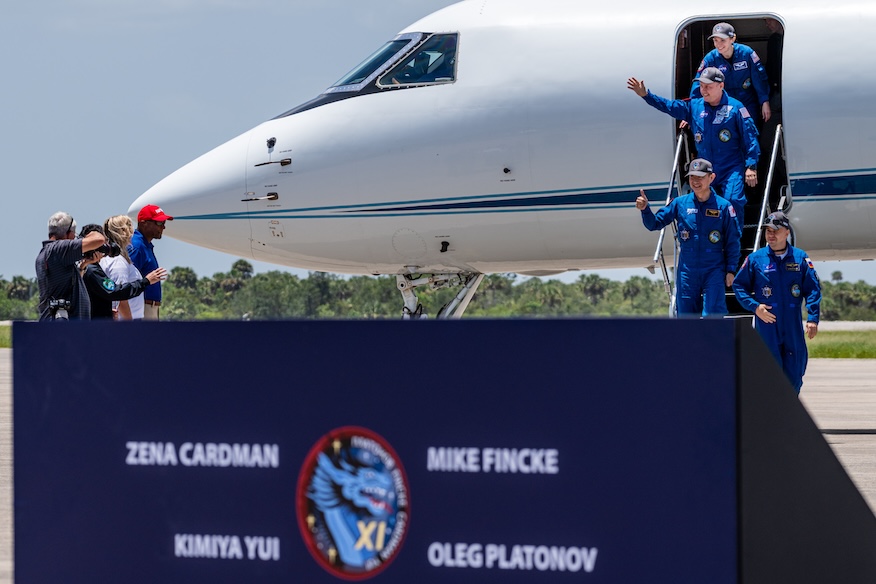

July 28, 7:14 PM update EDT: Stopped NASA’s comment, which is about the postponed static fire.
A problem with an indicator associated with the transporter eractor designed SpaceX to verify the health of Falcon 9 rockets on Monday, its planned mid-dopy rocket engine firing, which would take four humans to the international space station this week. Three astronauts and a cosmonot of the mission, dubbed crew -11, on Thursday, July 31, will have a long -term for a long period at the outpost with a lift -off plan for 31 July.
The launch company fueling its 70-meter-meter rocket in the launch complex 39A at NASA’s Kennedy Space Center and appeared on the track to ignite nine merlin engines for about 10-second-time. The operation is referred to as a stable fire test, as there is no plan to overtake the engine ignition to catch the rocket holding the rocket because they will be the days of launch.
However, the strong bench was seen returning to its pre-static fire position before starting from the EDT (1909 UTC) at 3:09 am about 30 seconds before the planned burning. NASA released a statement describing the issue on social media after about 3.5 hours and announced that the teams would try again on Tuesday, July 29.
NASA wrote, “Monday’s test is located in the auto-57 seconds due to an error with the transporter erar’s Cradle Arm Position Indication.” “Hands worked properly and the teams are reviewing the data. Falcon 9 and Dragon on Thursday, July 31 remain healthy on the pad before the pending static fire and launch of the launch.”
Three hours after the conclusion of a dry dress rehearsal, a static fire attempt came, in which astronauts rode the dragon with Falcon 9 un-fuel.
https://www.youtube.com/watch?v=wloua3bujxgg?
Falcon 9 First Stage Booster serial number B1094 for SpaceX Crew -11 mission. The rocket is flying for the third time, first launched Starlink 12–10 on 29 April, followed by the Ex-Mission 4 on 25 June.
The booster is not a stranger for discrepancies during a prelonch campaign. Next to the AX-4 mission, the booster also experienced a liquid oxygen leak which became clear during the static fire test. SpaceX officials said it stems from a leak that rose during a booster landing on a droneship between Starlink 10–12 missions in late April.
Prior to the launch of that private astronaut mission, William Garserere, vice -president of build and flight credibility for SpaceX, said the leak was being addressed in the pad. He said that the teams installed a nitrogen parj to reduce the leak and also addressed a vast vector control problem.
A fully integrated rocket rocked out of the hangar in LC -39A around midnight in Sunday morning. The rocket was launched in a position shortly before the EDT (1400 UTC) on Sunday at 10 am and the crew’s access arm was taken out with the crew’s dragon Endeavor to place themselves.
Dragon and Falcon 9 in Pad 39A pic.twitter.com/ojsiqo1yya
– SpaceX (@Spacex) 27 July, 2025
Mission Commander and NASA astronaut Zenna Cardman and his three crew companions arrived at KSC on Saturday afternoon amidst their employed quarantine periods, the standard for the mission for ISS. He and Oleg Platonov, one of the Roskosmos cosmonott and two mission experts, will first fly in space.
NASA’s astronaut and pilot Mike Finke is returning to space for the fourth time. The Japanese Aerospace Exploration Agency (Jaxa) Astronaut and Mission expert Kimia is traveling for Yui ISS.
The crew will stay and work at the station for at least six months. NASA and its international partners are considering extending the nominal mission to eight months to align more closely with the shifting timeline being put in place by Russia by Russia.
A final decision on the length of the mission is not expected to be about a month, which docks with the ISS with the crew -11.







